Magnetization Reversal in Concave Iron Nano-Superellipses
Abstract
1. Introduction
2. Materials and Methods
3. Results and Discussion
4. Conclusions
Supplementary Materials
Author Contributions
Funding
Institutional Review Board Statement
Informed Consent Statement
Data Availability Statement
Conflicts of Interest
References
- Reiss, G.; Hütten, A. Applications beyond data storage. Nat. Mater. 2005, 4, 725–726. [Google Scholar] [CrossRef] [PubMed]
- Harada, M.; Kuwa, M.; Sato, R.; Teranishi, T.; Takahashi, M.; Maenosono, S. Cation Distribution in Monodispersed MFe2O4 (M = Mn, Fe, Co, Ni, and Zn) Nanoparticles Investigated by X-ray Absorption Fine Structure Spectroscopy: Implications for Magnetic Data Storage, Catalysts, Sensors, and Ferrofluids. ACS Appl. Nano Mater. 2020, 3, 8389–8402. [Google Scholar] [CrossRef]
- Poornaprakash, B.; Ramu, S.; Subramanyam, K.; Kim, Y.; Kumar, M.; Reddy, M.S.P. Robust ferromagnetism of ZnO:(Ni + Er) diluted magnetic semiconductor nanoparticles for spintronic applications. Ceram. Int. 2021. [Google Scholar] [CrossRef]
- Almessiere, M.; Slimani, Y.; Guner, S.; Sertkol, M.; Korkmaz, A.D.; Shirsath, S.E.; Baykal, A. Sonochemical synthesis and physical properties of Co0.3Ni0.5Mn0.2EuxFe2−xO4 nano-spinel ferrites. Ultrason. Sonochem. 2019, 58, 104654. [Google Scholar] [CrossRef] [PubMed]
- Esfe, M.H.; Saedodin, S.; Mahian, O.; Wongwises, S. Efficiency of ferromagnetic nanoparticles suspended in ethylene glycol for applications in energy devices: Effects of particle size, temperature, and concentration. Int. Commun. Heat Mass Transf. 2014, 58, 138–146. [Google Scholar] [CrossRef]
- Barbucci, R.; Pasqui, D.; Giani, G.; De Cagna, M.; Fini, M.; Giardino, R.; Atrei, A. A novel strategy for engineering hydrogels with ferromagnetic nanoparticles as crosslinkers of the polymer chains. Potential applications as a targeted drug delivery system. Soft Matter 2011, 7, 5558–5565. [Google Scholar] [CrossRef]
- Abu-Bakr, A.F.; Zubarev, A.Y. Effect of ferromagnetic nanoparticles aggregation on magnetic hyperthermia. Eur. Phys. J. Spec. Top. 2020, 229, 323–329. [Google Scholar] [CrossRef]
- Slimani, Y.; Unal, B.; Hannachi, E.; Selmi, A.; Almessiere, M.A.; Nawaz, M.; Baykal, A.; Ercan, I.; Yildiz, M. Frequency and dc bias voltage dependent dielectric properties and electrical conductivity of BaTiO3-SrTiO3/(SiO2)x nanocomposites. Ceram. Int. 2019, 45, 11989–12000. [Google Scholar] [CrossRef]
- Mejía-López, J.; Altbir, D.; Romero, A.H.; Batlle, X.; Roshchin, I.V.; Li, C.-P.; Schuller, I.K. Vortex state and effect of anisotropy in sub-100-nm magnetic nanodots. J. Appl. Phys. 2006, 100, 104319. [Google Scholar] [CrossRef]
- Noske, M.; Stoll, H.; Fähnle, M.; Gangwar, A.; Woltersdorf, G.; Slavin, A.; Weigand, M.; Dieterle, G.; Förster, J.; Back, C.H.; et al. Three-dimensional character of the magnetization dynamics in magnetic vortex structures: Hybridization of flexure gyromodes with spin waves. Phys. Rev. Lett. 2016, 117, 037208. [Google Scholar] [CrossRef] [PubMed]
- Ehrmann, A.; Blachowicz, T. Systematic study of magnetization reversal in square Fe nanodots of varying dimensions in different orientations. Hyperfine Interact. 2018, 239, 48. [Google Scholar] [CrossRef]
- Ehrmann, A.; Blachowizc, T. Vortex and double-vortex nucleation during magnetization reversal in Fe nanodots of different dimensions. J. Magn. Magn. Mater. 2019, 475, 727–733. [Google Scholar] [CrossRef]
- Döpke, C.; Grothe, T.; Steblinski, P.; Klöcker, M.; Sabantina, L.; Kosmalska, D.; Blachowicz, T.; Ehrmann, A. Magnetic Nanofiber Mats for Data Storage and Transfer. Nanomaterials 2019, 9, 92. [Google Scholar] [CrossRef] [PubMed]
- Almessiere, M.; Slimani, Y.; Güner, S.; Nawaz, M.; Baykal, A.; Aldakheel, F.; Akhtar, S.; Ercan, I.; Belenli, I.; Ozçelik, B. Magnetic and structural characterization of Nb3+-substituted CoFe2O4 nanoparticles. Ceram. Int. 2019, 45, 8222–8232. [Google Scholar] [CrossRef]
- Almessiere, M.; Slimani, Y.; Korkmaz, A.; Taskhandi, N.; Sertkol, M.; Baykal, A.; Shirsath, S.E.; Ercan, I.; Ozçelik, B. Sonochemical synthesis of Eu3+ substituted CoFe2O4 nanoparticles and their structural, optical and magnetic properties. Ultrason. Sonochem. 2019, 58, 104621. [Google Scholar] [CrossRef] [PubMed]
- Sathisha, I.C.; Manjunatha, K.; Angadi, V.J.; Reddy, R.K. Structural, Microstructural, Electrical, and Magnetic Properties of CuFe2-(x + y)EuxScyO4 (where x and y vary from 0 to 0.03) Nanoparticles. J. Supercond. Novel Magn. 2020, 33, 3963–3973. [Google Scholar] [CrossRef]
- Kasperski, M.; Puszkarski, H.; Hoang, D.-T.; Diep, H.T. Magnetic properties of two-dimensional nanodots: Ground state and phase transition. AIP Adv. 2013, 3, 122121. [Google Scholar] [CrossRef]
- Vavassori, P.; Zaluzec, N.; Metlushko, V.; Novosad, V.; Ilic, B.; Grimsditch, M. Magnetization reversal via single and bouble vortex states in submicron Permalloy ellipses. Phys. Rev. B 2004, 69, 214404. [Google Scholar] [CrossRef]
- Guslienko, K.Y.; Buchanan, K.S.; Bader, S.D.; Novosad, V. Dynamics of coupled vortices in layered magnetic nanodots. Appl. Phys. Lett. 2005, 86, 223112. [Google Scholar] [CrossRef]
- Prosandeev, S.; Bellaiche, L. Controlling Double Vortex States in Low-Dimensional Dipolar Systems. Phys. Rev. Lett. 2008, 101, 097203. [Google Scholar] [CrossRef] [PubMed]
- Vavassori, P.; Grimsditch, M.; Novosad, V.; Metlushko, V.; Ilic, B. Metastable states during magnetization reversal in square permalloy rings. Phys. Rev. B 2003, 67, 134429. [Google Scholar] [CrossRef]
- Remhof, A.; Schumann, A.; Westphalen, A.; Last, T.; Kunze, U.; Zabel, H. Dipolar interactions in periodic arrays of rectangular ferromagnetic islands. J. Magn. Magn. Mater. 2007, 310, e794–e796. [Google Scholar] [CrossRef]
- Zabel, H.; Schumann, A.; Westphalen, A.; Remhof, A. Order and Frustration in Artificial Magnetic Patterns. Acta Phys. Pol. A 2009, 115, 59–63. [Google Scholar] [CrossRef]
- Gao, X.; Liu, L.; Birajdar, B.; Ziese, M.; Lee, W.; Alexe, M.; Hesse, D. High-Density Periodically Ordered Magnetic Cobalt Ferrite Nanodot Arrays by Template-Assisted Pulsed Laser Deposition. Adv. Funct. Mater. 2009, 19, 3450–3455. [Google Scholar] [CrossRef]
- Li, Z.; Gao, S.; Brand, U.; Hiller, K.; Hahn, S.; Hamdana, G.; Peiner, E.; Wolff, H.; Bergmann, D. Nanomechanical character-ization of vertical nanopillars using an MEMS-SPM nano-bending testing platform. Sensors 2019, 19, 4529. [Google Scholar] [CrossRef] [PubMed]
- Ehrmann, A.; Blachowicz, T.; Komraus, S.; Nees, M.-K.; Jakobs, P.-J.; Leiste, H.; Mathes, M.; Schaarschmidt, M. Magnetic properties of square Py nanowires: Irradiation dose and geometry dependence. J. Appl. Phys. 2015, 117, 173903. [Google Scholar] [CrossRef]
- Blachowicz, T.; Ehrmann, A.; Steblinski, P.; Palka, J. Directional-dependent coercivities and magnetization reversal mechanisms in fourfold ferromagnetic systems of varying sizes. J. Appl. Phys. 2013, 113, 013901. [Google Scholar] [CrossRef]
- Huang, W.W.; Li, Y.Y.; Niklas, K.J.; Gielis, J.; Ding, Y.Y.; Cao, L.; Shi, P.J. A superellipse with deformation and its application in describing the cross-sectional shapes of a square bamboo. Symmetry 2020, 12, 2073. [Google Scholar] [CrossRef]
- Castán-Guerrero, C.; Herrero-Albillos, J.; Bartolomé, J.; Rodríguez, L.A.; Magén, C.; Kronast, F.; Gawronski, P.; Chubykalo-Fesenko, O.; Merazzo, K.J.; Vavassori, P.; et al. Magnetic antidot to dot crossover in Co and Py nanopatterned thin films. Phys. Rev. B 2014, 89, 144405. [Google Scholar] [CrossRef]
- Sudsom, D.; Ehrmann, A. Micromagnetic Simulations of Fe and Ni Nanodot Arrays Surrounded by Magnetic or Non-Magnetic Matrices. Nanomaterials 2021, 11, 349. [Google Scholar] [CrossRef]
- Janutka, A.; Gawronski, P. Spin-Transfer Driven Dynamics of Magnetic Vortices and Antivortices in Dots with Crystalline Cubic Anisotropy. IEEE Trans. Magn. 2017, 53, 1. [Google Scholar] [CrossRef]
- Wang, H.; Campbell, C.E. Spin dynamics of a magnetic antivortex: Micromagnetic simulations. Phys. Rev. B 2007, 76, 220407. [Google Scholar] [CrossRef]
- Xing, X.J.; Yu, Y.P.; Wu, S.X.; Xu, L.M.; Li, S.W. Bloch-point-mediated magnetic antivortex core reversal triggered by sudden excitation of a suprathreshold spin-polarized current. Appl. Phys. Lett. 2008, 93, 202507. [Google Scholar] [CrossRef]
- Gliga, S.; Hertel, R.; Schneider, C.M. Switching a magnetic antivortex core with ultrashort field pulses. J. Appl. Phys. 2008, 103, 7. [Google Scholar] [CrossRef]
- Gliga, S.; Yan, M.; Hertel, R.; Schneider, C.M. Ultrafast dynamics of a magnetic antivortex: Micromagnetic simulations. Phys. Rev. B 2008, 77, 060404. [Google Scholar] [CrossRef]
- Donahue, M.J.; Porter, D.G. OOMMF User’s Guide, Version 1.0; National Institute of Standards and Technology (NIST): Gaithersburg, MD, USA, 1999. [Google Scholar]
- Kneller, E.F.; Hawig, R. The exchange-spring magnet: A new material principle for permanent magnets. IEEE Trans. Magn. 1991, 27, 3588–3560. [Google Scholar] [CrossRef]
- Tillmanns, A.; Blachowicz, T.; Fraune, M.; Güntherodt, G.; Schuller, I.K. Anomalous magnetization reversal mechanism in unbiased Fe/FeF2 investigated by means of the magneto-optic Kerr effect. J. Magn. Magn. Mater. 2009, 321, 2932–2935. [Google Scholar] [CrossRef]
- Blachowicz, T.; Ehrmann, A. Exchange Bias in Thin Films—An Update. Coatings 2021, 11, 122. [Google Scholar] [CrossRef]
- Detzmeier, J.; Königer, K.; Blachowicz, T.; Ehrmann, A. Asymmetric hysteresis loops in structured ferromagnetic nanoparticles with hard/soft areas. Nanomaterials 2021, 11, 800. [Google Scholar] [CrossRef] [PubMed]
- Grimsditch, M.; Hoffmann, A.; Vavassori, P.; Shi, H.T.; Lederman, D. Exchange-induced anisotropies at ferromagnetic-antiferromagnetic interfaces above and below the Néel temperature. Phys. Rev. Lett. 2003, 90, 257201. [Google Scholar] [CrossRef] [PubMed]
- Pardavi-Horvath, M.; Ross, C.; McMichael, R. Shape effects in the ferromagnetic resonance of nanosize rectangular permalloy arrays. IEEE Trans. Magn. 2005, 41, 3601–3603. [Google Scholar] [CrossRef]
- Blachowicz, T.; Tillmanns, A.; Fraune, M.; Ghadimi, R.; Beschoten, B.; Güntherodt, G. Exchange bias in epitaxial CoO/Co bilayers with different crystallographic symmetries. Phys. Rev. B 2007, 75, 054425. [Google Scholar] [CrossRef]
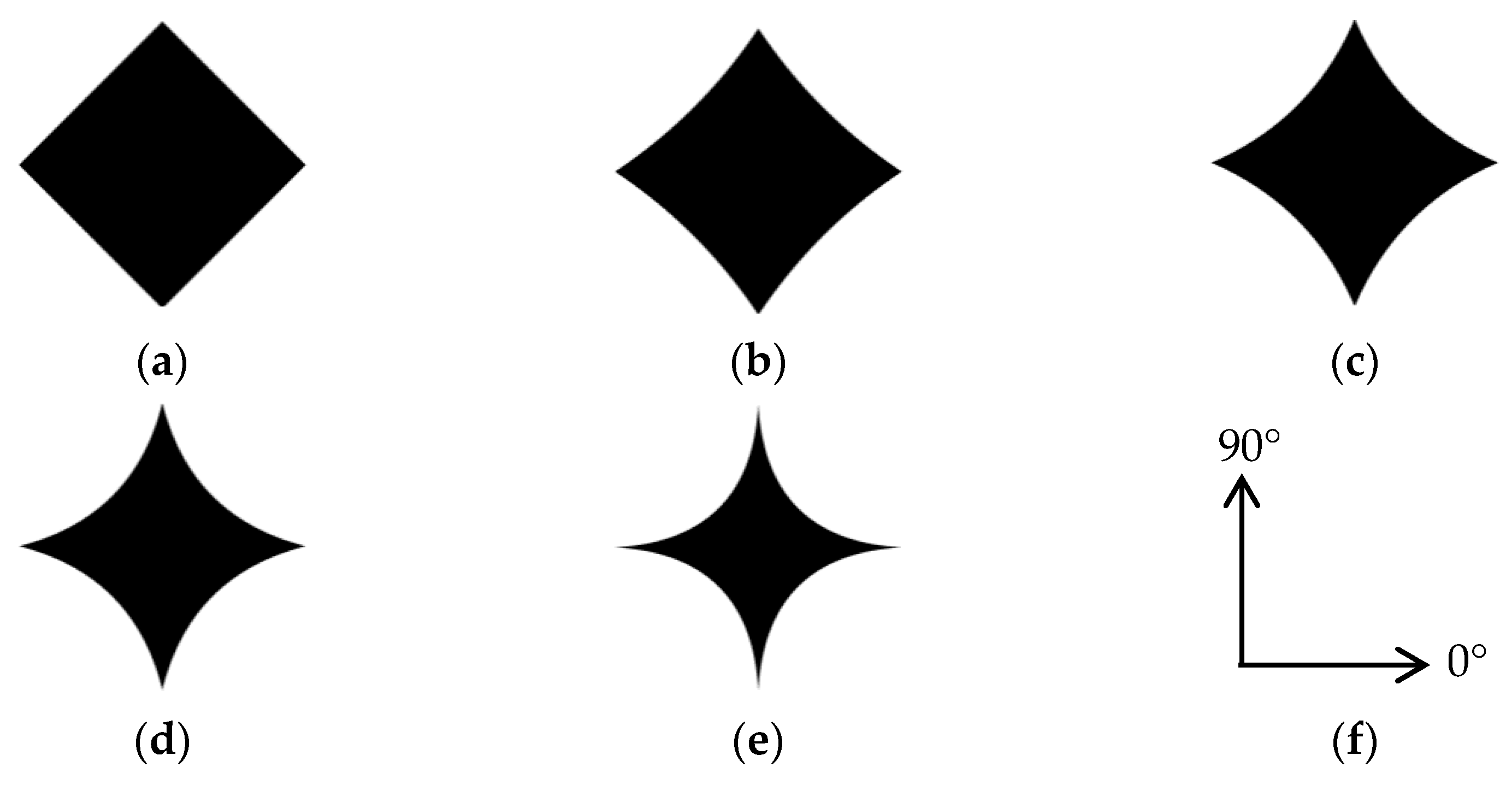
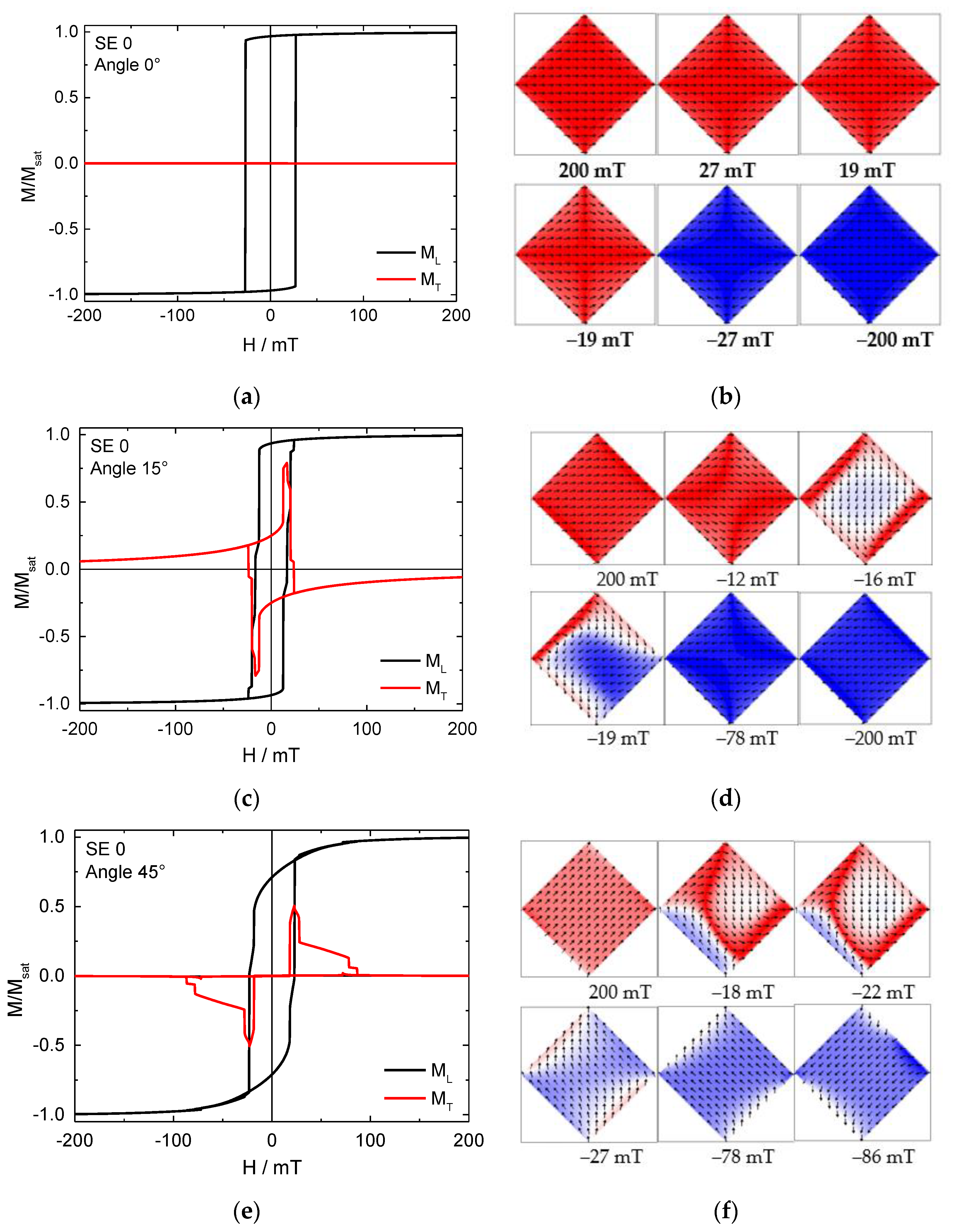
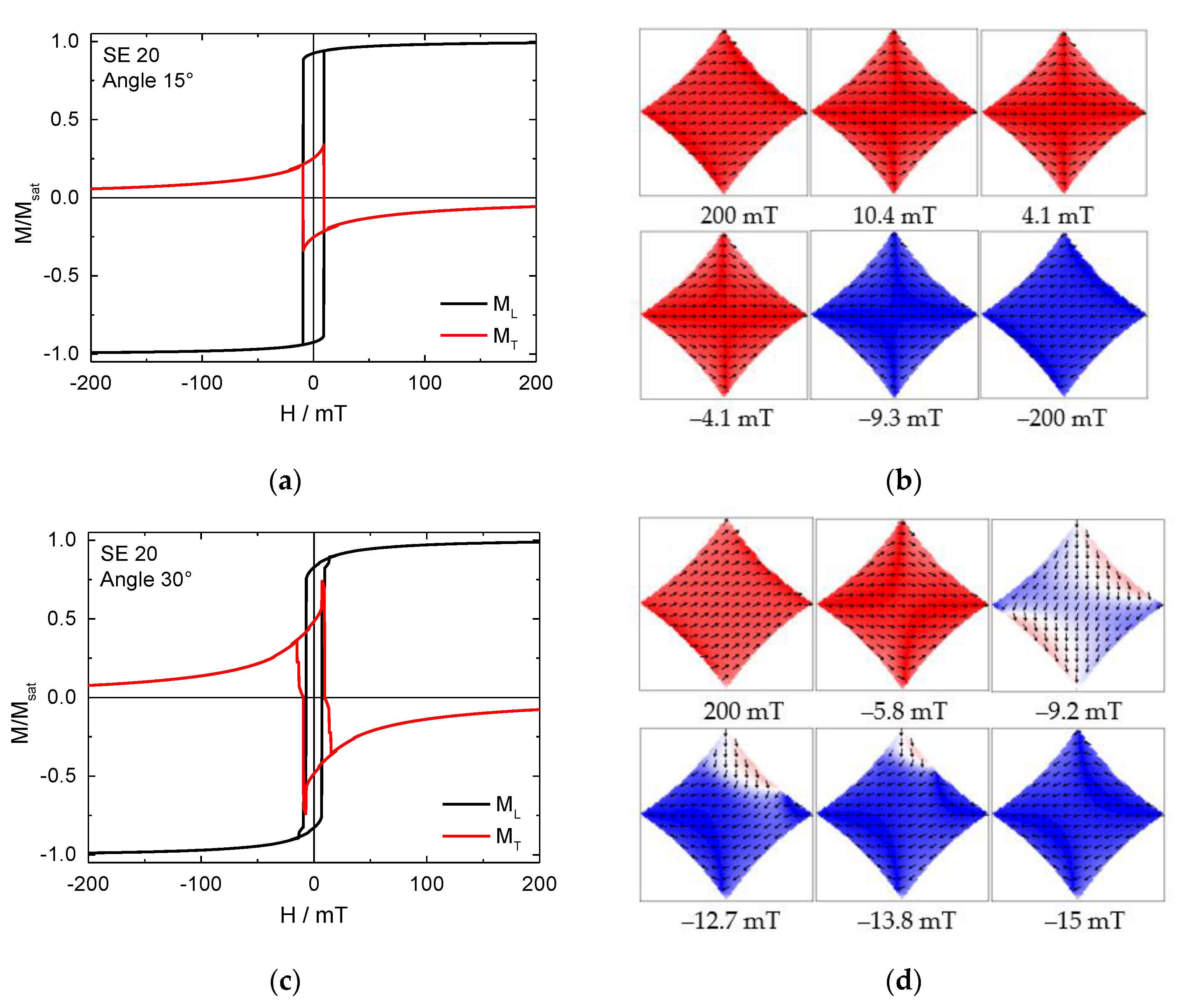
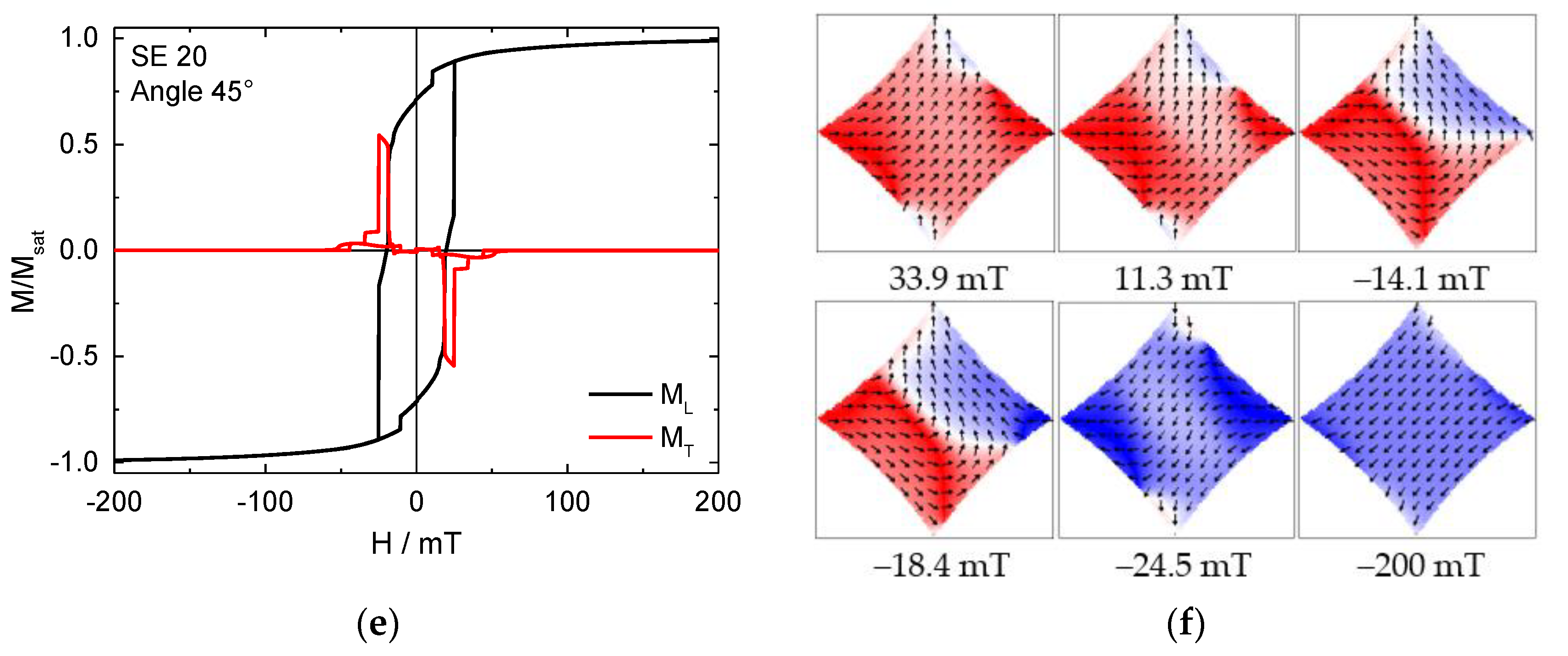
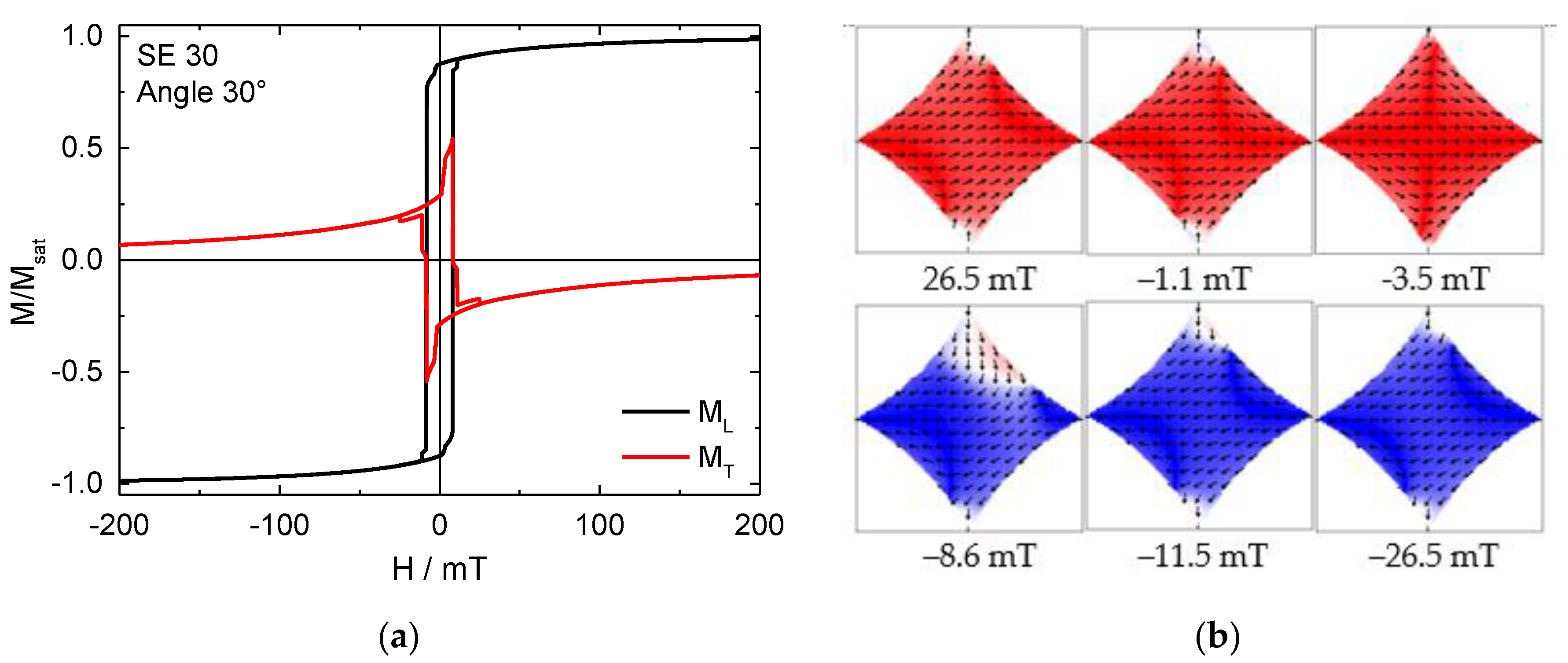
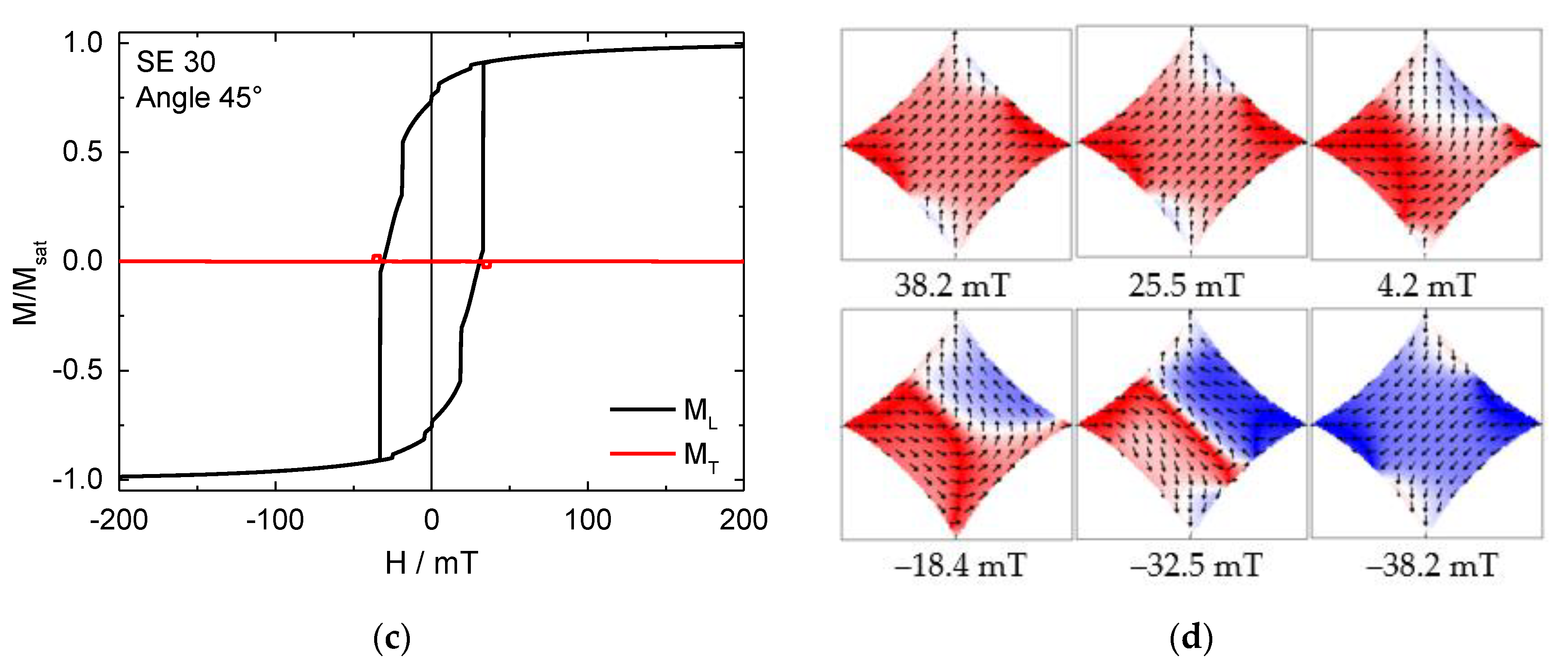
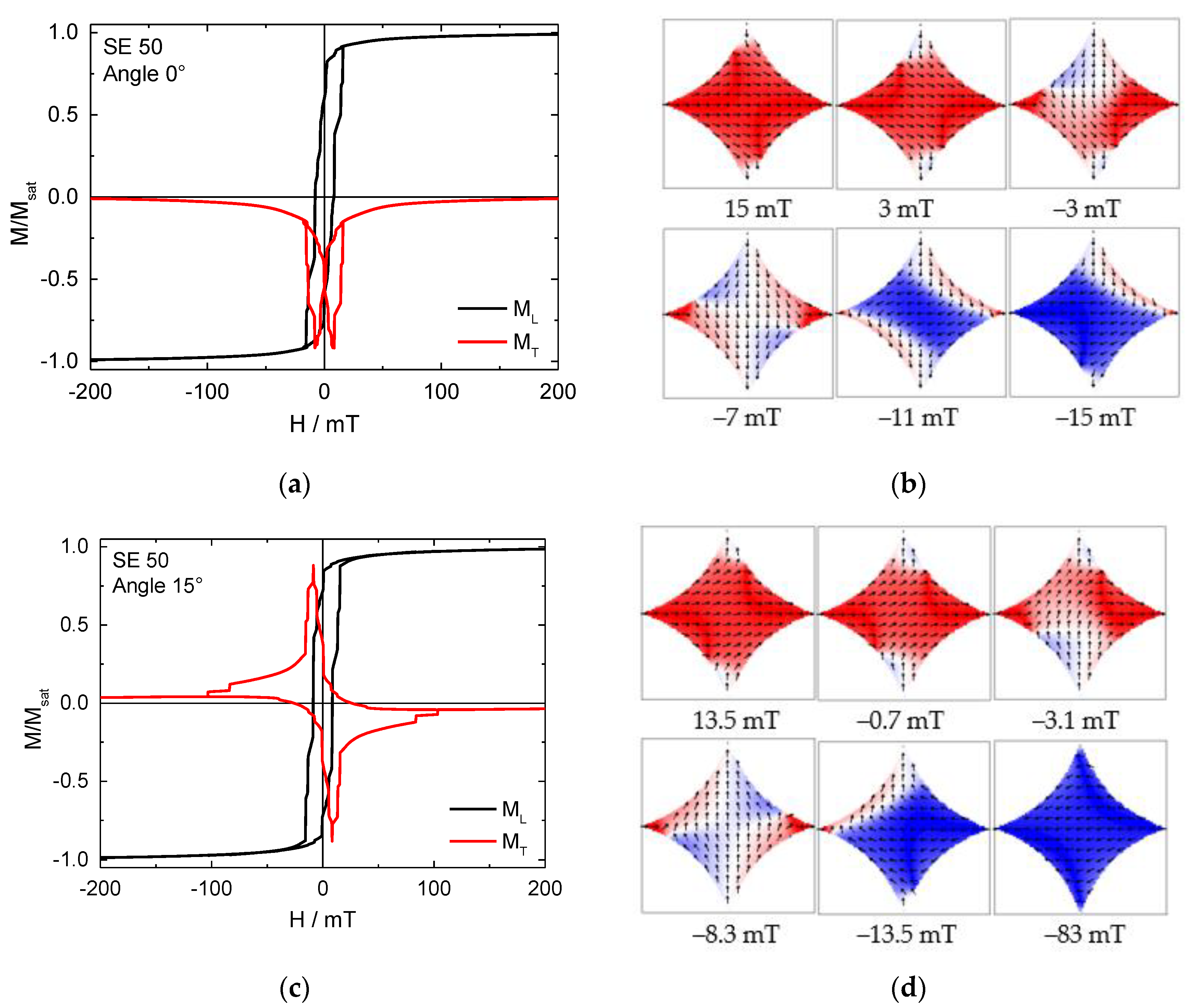
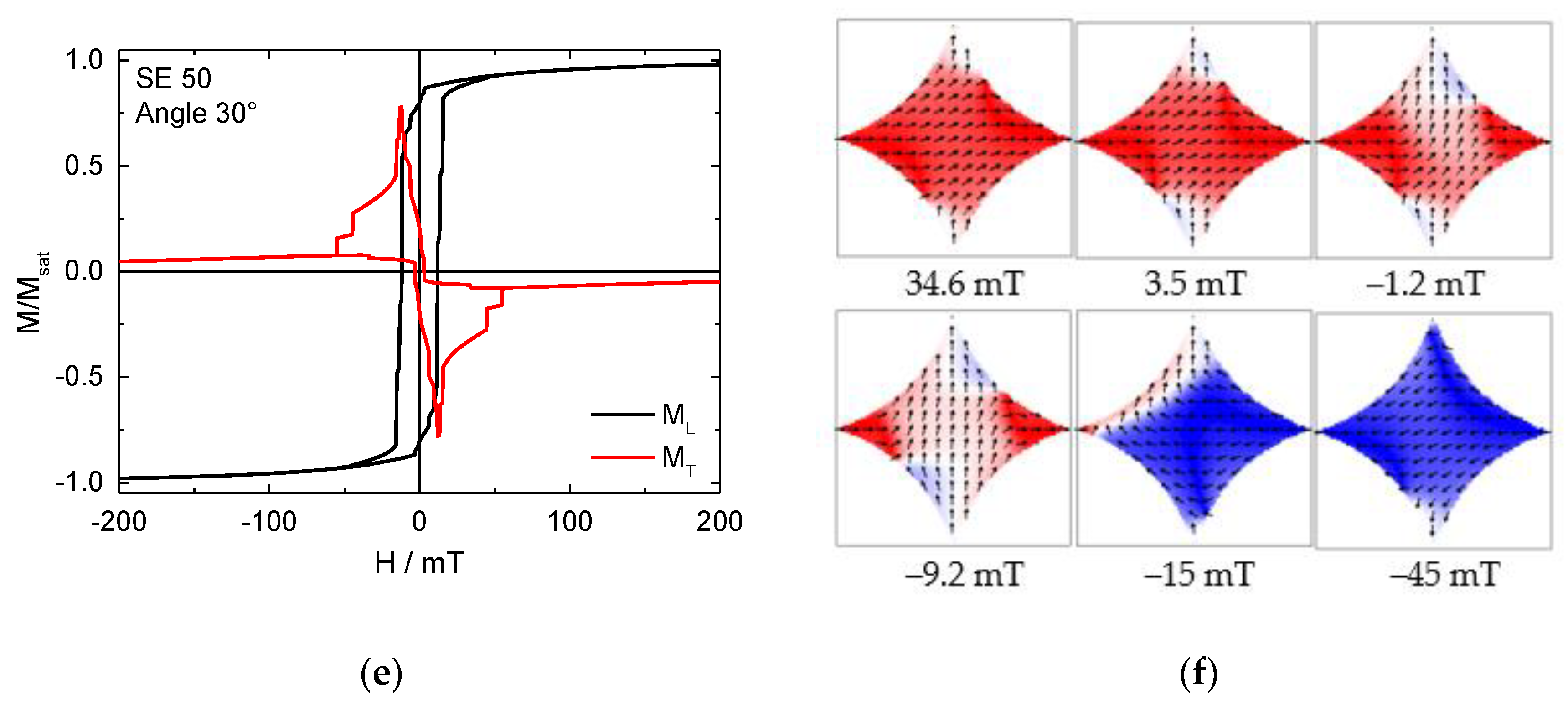
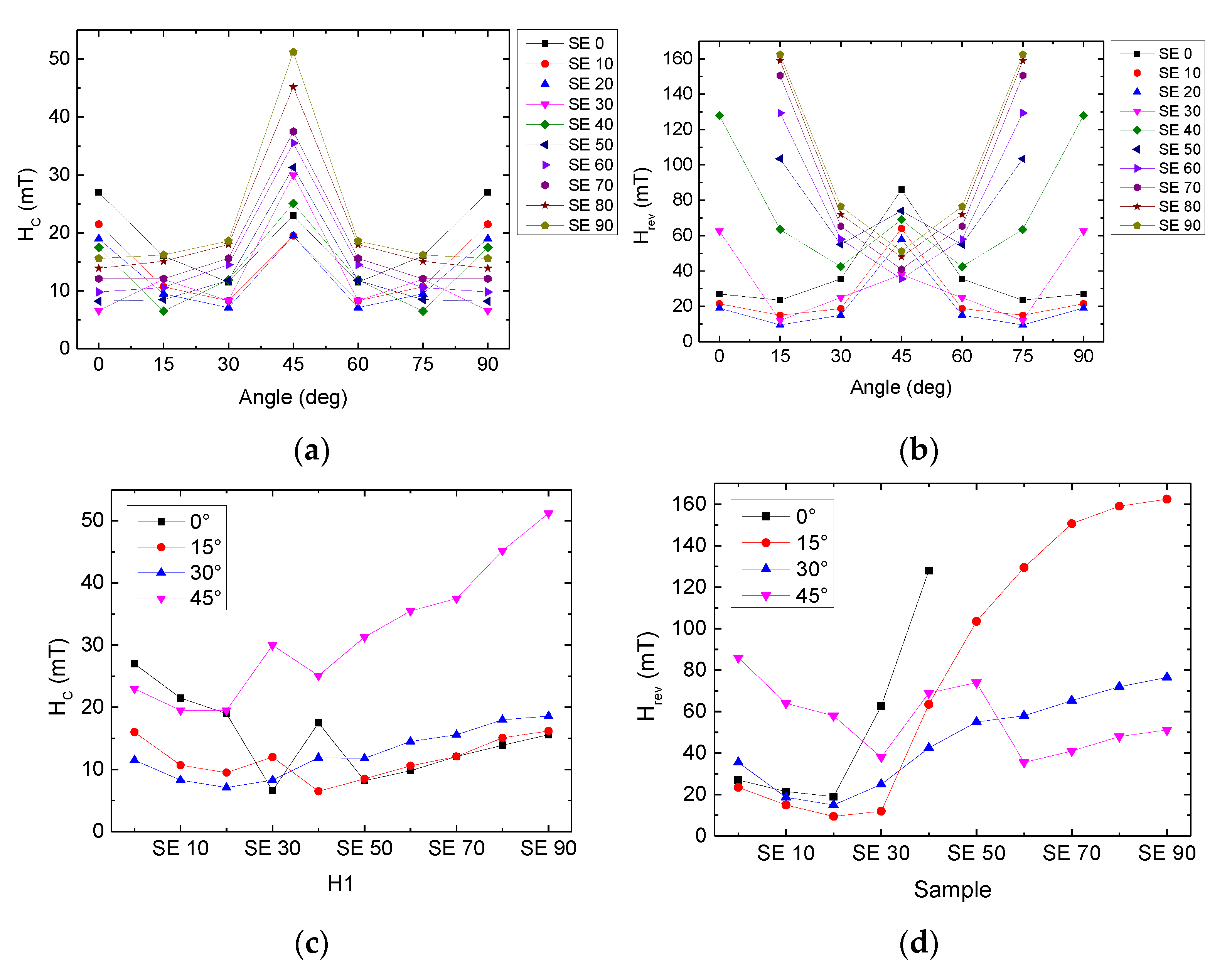
Publisher’s Note: MDPI stays neutral with regard to jurisdictional claims in published maps and institutional affiliations. |
© 2021 by the authors. Licensee MDPI, Basel, Switzerland. This article is an open access article distributed under the terms and conditions of the Creative Commons Attribution (CC BY) license (https://creativecommons.org/licenses/by/4.0/).
Share and Cite
Öncü, E.; Ehrmann, A. Magnetization Reversal in Concave Iron Nano-Superellipses. Condens. Matter 2021, 6, 17. https://doi.org/10.3390/condmat6020017
Öncü E, Ehrmann A. Magnetization Reversal in Concave Iron Nano-Superellipses. Condensed Matter. 2021; 6(2):17. https://doi.org/10.3390/condmat6020017
Chicago/Turabian StyleÖncü, Emre, and Andrea Ehrmann. 2021. "Magnetization Reversal in Concave Iron Nano-Superellipses" Condensed Matter 6, no. 2: 17. https://doi.org/10.3390/condmat6020017
APA StyleÖncü, E., & Ehrmann, A. (2021). Magnetization Reversal in Concave Iron Nano-Superellipses. Condensed Matter, 6(2), 17. https://doi.org/10.3390/condmat6020017






